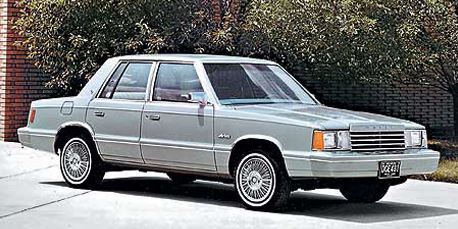When I first visited the U.S. of A. back in 1982 (honeymoon with Wife #1), I decided to do a LONG drive trip around the eastern U.S. — a four-day drive from NYfC to Boston and into New Hampshire and Maine, then back down to Manhattan for a day or two, and then carrying on down to New Orleans, then to Florida (Disney World), and back up the eastern seaboard to NYfC before flying home to the old Racist Republic. The trip ended up taking us just under a month.
Bear in mind that I’d never driven on the right-hand side of the road, and there was no Wayze or GurgleMaps, just a Rand-McNally atlas.
That wasn’t a problem. This was.
In South Africa, there are no concrete roads; all are asphalt, and at least as far as the freeways are concerned, very smooth. Imagine then my surprise when I got to the Greatest Country On Earth, set out on the interstate highways and had to endure three weeks of “ker-chunk-ker-chunk-ker-chunk” as the highway joints chattered away under the tires of the rented Dodge Aries, driving me to near-insanity.

WTF? I’ve heard all the arguments in favor of concrete as a road surface, and none of them make up for the most unpleasant driving experience on Earth. As for the “concrete lasts longer in extreme heat conditions than asphalt” argument, please note that in South Africa (where sweltering heat is not exactly an unknown weather condition) the asphalt roads bear up perfectly well.
Indeed, when I went back to Seffrica back in 2017, I had occasion to drive from Johannesburg to Pretoria and back (about 140-odd miles) on the N3/N1 motorways, which were in perfect condition AND being asphalt, there was no road noise. (Ditto of course in Britishland, where I’d been likewise driving around Hardy Country in a Ford Focus.)

This was brought home to me quite recently when I discovered that Plano has started covering some of our concrete suburban roads with asphalt. The change in the driving experience (and therefore my mood) has been dramatic. My only gripe is that the process isn’t going fast enough, and to my dismay I notice that all the road repairs currently underway [20,000-word rant deleted] are being made by re-laying concrete slabs, rather than just covering the affected areas with asphalt.
Whichever American first made the decision to go with a concrete road surface over asphalt should have been thrown into a revolving concrete mixer for a week.

Disneyland isn’t in Florida.. it’s in Anaheim, CA. Disney World is in Florida.
They all look the same to me.
Most likely the company selling concrete bought a better politician than the guy selling asphalt.
If they’re relaying the concrete, then laying a wearing surface of asphalt, you get the benefits of both. Concrete bridges voids in the subgrade, avoiding the potholes you get with asphalt.
I wonder what keeps the asphalt in S.A. so much better? More suitable native subgrade soils? Better mix design? It would be interesting to know.
Some time ago the commute to my job required transiting a ~4 mile stretch of concrete roadway. The road itself was still sound but had a large number of both slab joints and cracks, both of which admitted water which (this being Illinois) then froze and caused the gaps to get increasingly larger. For the space of about 7 years the solution to the deteriorating roadway was to shut down a lane, cut out the concrete on either side of a particularly egregious gap, and pour new concrete. This would go on all summer long (there were a lot of cracks), totally screwing thousands of commuters morning and night. The problem with this plan which they failed to grasp was that for every gap they “fixed” they created 2 more gaps which would subsequently fail. I personally witnessed many cases where there was a fix to one of the newly created gaps from a previous fix. This continued until they finally put a layer of asphalt on top of the concrete. It hasn’t needed a single repair in 20 years since then.
Four words that will cause a Pennsylvanian to cry: “Fresh Oil and Chips”
Mark D
Having grown up in a house on a gravel road several miles outside of town, (and miles from the nearest state or county road with solid surfaces) concrete roads were a major improvement to me as I started driving.
How much snow and ice did you get in South Africa?
When I lived in Miami, I95 was all concrete slabs. about 8 years ago, they brought in a Zamboni – like machine and shaved the concrete smooth, and paved with asphalt. I agree, what a difference.
They’ve done the same with most, if not all, of I-75 here on the Gulf Coast. When we drive home to visit my family in Tennessee, there’s a huge difference between the asphalt road surface here in Florida and the concrete surface in South Georgia.
Since you’re familiar with chicagoland, you may also recall one of the disadvantages of asphalt roads relative to concrete. When corrupt politicians pay too much to crappy but connected contractors to use the cheapest shit possible to repave roads so that they get to do it again every few years, and the drivers get to deal with major roads and freeways under perpetual construction…
Often times the road bed needs to be excavated and better material put in place. The better material is one that drains water away easily and quickly. My first job out of college was with a road and bridge contractor. There are testing standards for soil and asphalt as well as concrete. The problem I found is that few projects entail building a good foundation for the asphalt road on top. Then on top of that put in place crooked state employees and contractors who are more than happy to pass an unmarked envelope across to compromise quality.
JQ